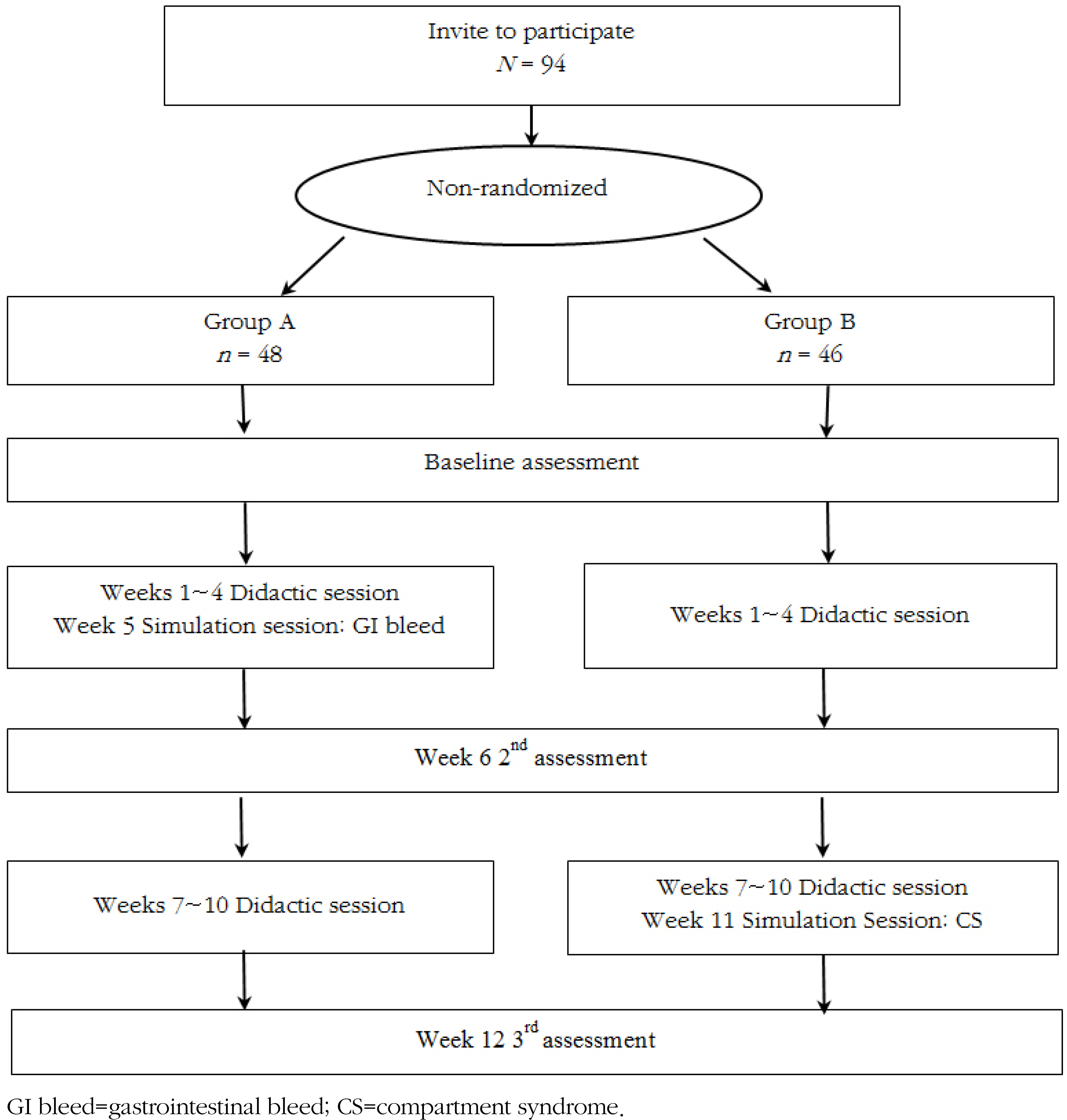Korean J Adult Nurs.
2015 Oct;27(5):604-611. 10.7475/kjan.2015.27.5.604.
Effects of Simulation on Nursing Students' Knowledge, Clinical Reasoning, and Self-confidence: A Quasi-experimental Study
- Affiliations
-
- 1College of Nursing, Research Institute of Nursing Science, Chonbuk National University, Jeonju, Korea.
- 2Division of Nursing, Research Institute of Nursing Science, Hallym University, Chuncheon, Korea. ejerkim@hallym.ac.kr
- KMID: 2221738
- DOI: http://doi.org/10.7475/kjan.2015.27.5.604
Abstract
- PURPOSE
Knowledge, clinical reasoning, and self-confidence are the basis for undergraduate education, and determine students\' level of competence. The purpose of this study was to assess the effects of the addition of a one-time simulation experience to the didactic curriculum on nursing students' knowledge acquisition, clinical reasoning skill, and self-confidence.
METHODS
Using a quasi-experimental crossover design consisted of intervention and wait-list control groups. Participants were non-randomly assigned to the first intervention group (Group A, n=48) or the wait-list control group (Group B, n=46). Knowledge level was assessed through a multiple choice written test, and clinical reasoning skill was measured using a nursing process model-based rubric. Self-confidence was measured using a self-reported questionnaire.
RESULTS
Results indicated that students in the simulation group scored significantly higher on clinical reasoning skill and related knowledge than those in the didactic lecture group; no difference was found for self-confidence.
CONCLUSION
Findings suggest that undergraduate nursing education requires a simulation-based curriculum for clinical reasoning development and knowledge acquisition.
MeSH Terms
Figure
Cited by 1 articles
-
Effect of Team Debriefing in Simulation-based Cardiac Arrest Emergency Nursing Education
SangJin Ko, Eun-Hee Choi
Korean J Adult Nurs. 2017;29(6):667-676. doi: 10.7469/KJAN.2017.29.6.667.
Reference
-
1.Brown JS., Collins A., Duguid S. Situated cognition and the culture of learning. Educational Researcher. 1989. 18(1):32–42. http://dx.doi.org/10.3102/0013189X018001032.
Article2.Wotton K., Davis J., Button D., Kelton M. Third-year undergraduate nursing student's perceptions of high-fidelity simulation. Journal of Nursing Education. 2010. 49(11):632–9. http://dx.doi.org/10.3928/01484834-20100831-01.
Article3.Jeffries PR. A framework for designing, implementing, and evaluating simulations used as teaching strategies in nursing. Nursing Education Perspectives. 2005. 26(2):96–103.4.Weaver A. High-fidelity patient simulation in nursing education: an integrative review. Nursing Education Perspectives. 2011. 32(1):37–40. http://dx.doi.org/10.5480/1536-5026-32.1.37.5.Hicks F., Coke L., Li S. The effect of high-fidelity simulation on nursing students'knowledge and performance: a pilot study. 2009. [cited 2014 April 7]. Available from:. https://www.ncsbn.org/09_SimulationStudy_Vol40_web_with_cover.pdf.6.Gates MG., Parr MB., Hughen JE. Enhancing nursing knowledge using high-fidelity simulation. Journal of Nursing Education. 2012. 51(1):9–15. http://dx.doi.org/10.3928/01484834-20111116-01.
Article7.Murphy JI. Using focused reflection and articulation to promote clinical reasoning: an evidence-based teaching strategy. Nursing Education Perspectives. 2004. 25(5):226–31.8.Tanner CA. Thinking like a nurse: a research-based model of clinical judgment in nursing. Journal of Nursing Education. 2006. 45(6):204–11.9.Burns HK., O'Donnell J., Artman J. High-fidelity simulation in teaching problem solving to 1st-year nursing students: a novel use of the nursing process. Clinical Simulation in Nursing. 2010. 6(3):e87–e95. http://dx.doi.org/10.1016/j.ecns.2009.07.005.10.Lisko S., O'Dell V. Integration of theory and practice: experiential learning theory and nursing education. Nursing Education Perspectives. 2010. 31(2):106–8.11.Lapkin S., Levett-Jones T., Bellchambers H., Fernandez R. Effectiveness of patient simulation manikins in teaching clinical reasoning skills to undergraduate nursing students: a systematic review. Clinical Simulation in Nursing. 2010. 6(6):e207–22. http://dx.doi.org/10.1016/j.ecns.2010.05.005.
Article12.Lundberg KM. Promoting self-confidence in clinical nursing students. Nurse Educator. 2008. 33(2):86–9. http://dx.doi.org/10.1097/01.NNE.0000299512.78270.d0.
Article13.Clark MC., Owen SV., Tholcken MA. Measuring student perceptions of clinical competence. Journal of Nursing Education. 2004. 43(12):548–54.
Article14.Cant RP., Cooper SJ. Simulation-based learning in nurse education: systematic review. Journal of Advanced Nursing. 2010. 66(1):3–15. http://dx.doi.org/10.1111/j.1365-2648.2009.05240.x.
Article15.Brown D., Chronister C. The effect of simulation learning on critical thinking and self-confidence when incorporated into an electrocardiogram nursing course. Clinical Simulation in Nursing. 2009. 5(1):e45–52. http://dx.doi.org/10.1016/j.ecns.2008.11.001.
Article16.Bambini D., Washburn J., Perkins R. Outcomes of clinical simulation for novice nursing students: communication, confidence, clinical judgment. Nursing Education Perspectives. 2009. 30(2):79–82.17.Smith S., Roehrs C. High fidelity simulation: factors correlated with nursing student satisfaction and self-confidence. Nursing Education Perspectives. 2009. 30(2):74–8.18.Alinier G., Hunt B., Gordon R., Harwood C. Effectiveness of intermediate-fidelity simulation training technology in undergraduate nursing education. Journal of Advanced Nursing. 2006. 54(3):359–69. http://dx.doi.org/10.1111/j.1365-2648.2006.03810.x.
Article19.Chang S., Kwon E., Kwon YO., Kwon HK. The effects of simulation training for new graduate critical care nurses on knowledge, self-efficacy, and performance ability of emergency situations at intensive care unit. Journal of Korean Academic Adult Nursing. 2010. 22(4):375–83.20.Yuan HB., Williams BA., Fang JB. The contribution of high-fidelity simulation to nursing students' confidence and competence: a systematic review. International Nursing Review. 2012. 59(1):26–33. http://dx.doi.org/10.1111/j.1466-7657.2011.00964.x.
Article21.Meyer MN., Connors H., Hou O., Gajewski B. The effect of simulation on clinical performance: a junior nursing student clinical comparison study. Simulation in Healthcare. 2011. 6(5):269–77. http://dx.doi.org/10.1097/SIH.0b013e318223a048.22.Rhodes ML., Curran C. Use of the human patient simulator to teach clinical judgment skills in a baccalaureate nursing program. CIN: Computers, Informatics, Nursing. 2005. 23(5):256–62.
Article23.Baillie L., Curzio J. Students'and facilitators'perceptions of simulation in practice learning. Nurse Education in Practice. 2009. 9(5):297–306. http://dx.doi.org/10.1016/j.nepr.2008.08.007.24.Bandura A. Social foundations of thought and action: asocial cognitive theory. Englewood Cliffs, NJ: Prentice Hall;1986.
- Full Text Links
- Actions
-
Cited
- CITED
-
- Close
- Share
- Similar articles
-
- Effects of a Nursing Simulation Learning Module on Clinical Reasoning Competence, Clinical Competence, Performance Confidence, and Anxiety in COVID-19 Patient-Care for Nursing Students
- Effectiveness of Student Learning with a Simulation Program focusing on Cardiac Arrest in Knowledge, Self-confidence, Critical Thinking, and Clinical Performance Ability
- Effect of a Simulated Education-based Hypoglycemia Scenario Using a High-fidelity Simulator on Acquisition and Retention of Diabetes Knowledge and Academic Self-efficacy in Nursing Students
- Relationship between Simulation Design Characteristics and Clinical Reasoning Competence: Multiple Additive Moderating Effects of Teaching Effectiveness and Students’ Anxiety on Nursing Students
- Effect of Practical Delivery-nursing Simulation Education on Team-based Learning on the Nursing Knowledge, Self-efficacy, and Clinical Competence of Nursing Students


